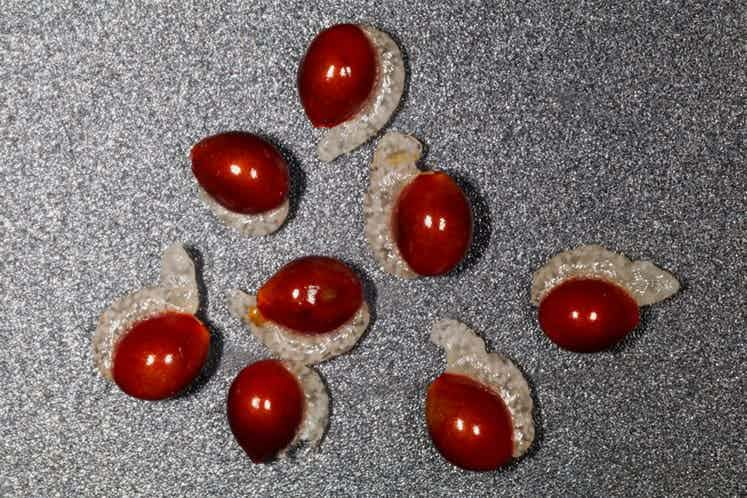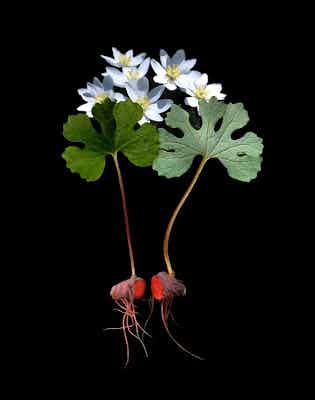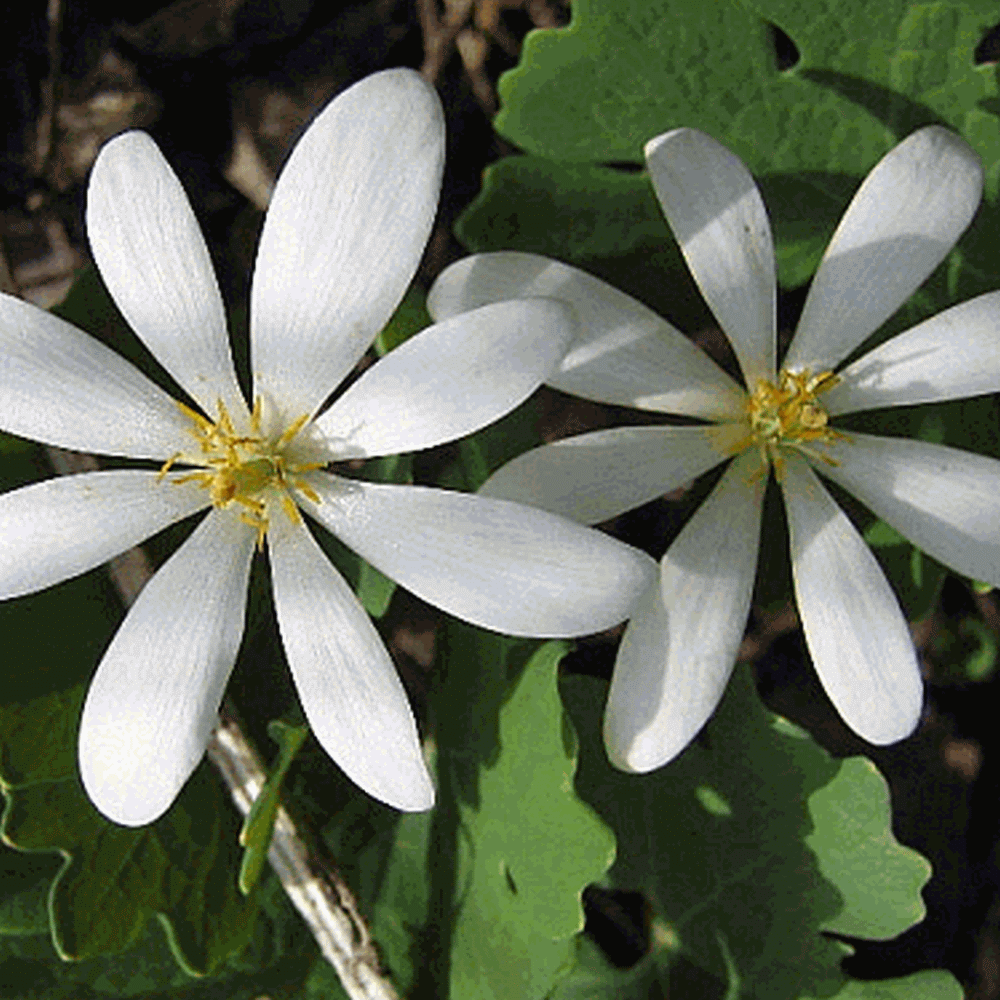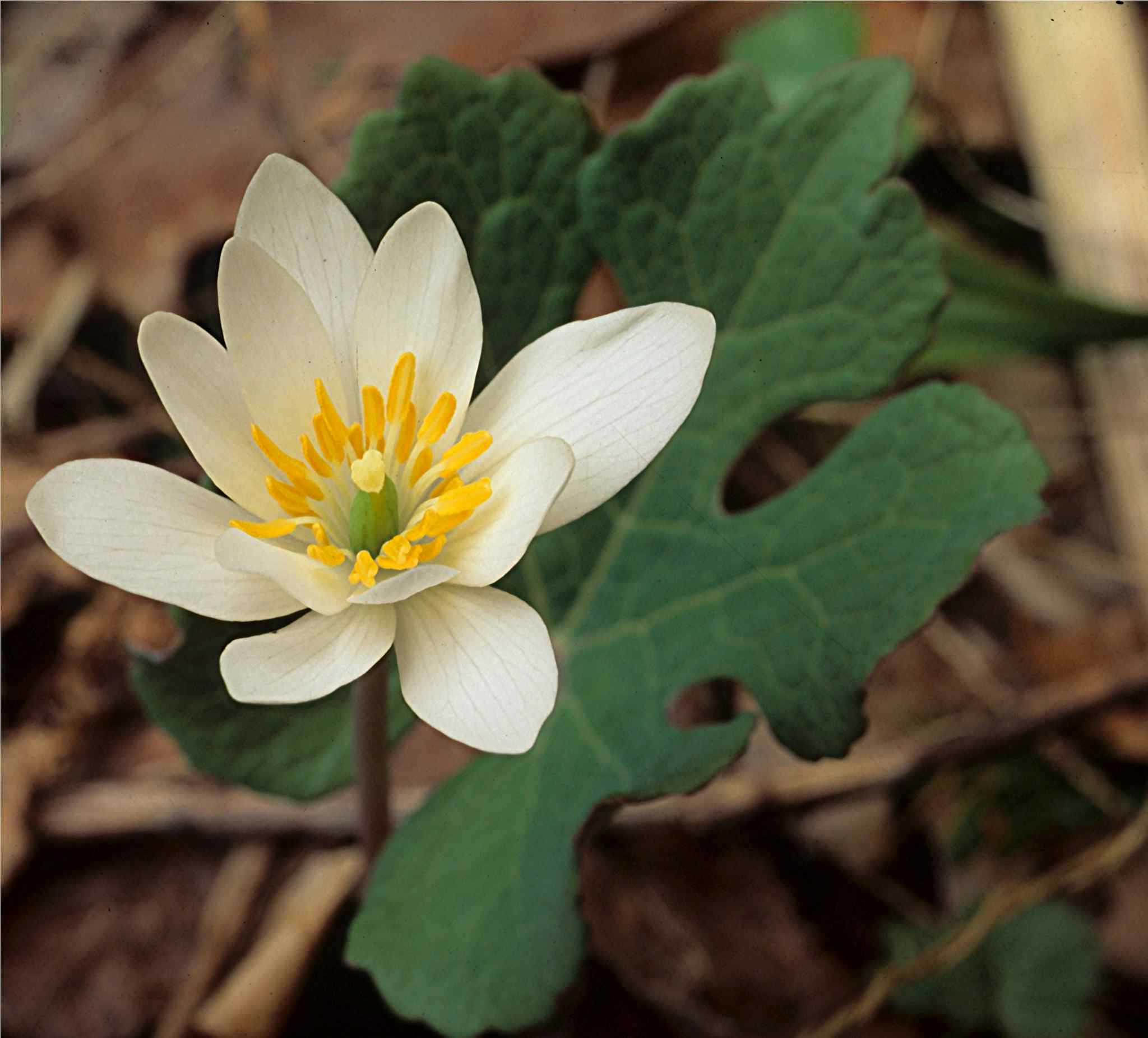Botanical Information
Bloodroot, Sanguinaria canadensis L., is a member of the Papaveraceae family. It is a native spring wildflower that grows in rich woodlands of North America from Nova Scotia to Florida and west to Alabama, Arkansas, Nebraska, and Manitoba. It can grow in full sun, but is more often found in semi-shaded, light-wooded areas with moist, acidic soil. A perennial that grows up to ten inches tall, the plant has a single, basal leaf that can be as wide as eight inches. The flower is located on a separate stalk and is white with a yellow center. Bloodroot is one of the first wildflowers to bloom beginning in late winter and continuing into early spring. The "root", consisting of a thickened rhizome covered with fibrous roots, is known for its reddish-orange color.
Bioactive Components
The main bioactive components of bloodroot are alkaloids, primarily sanguinarine. Others include chelerythrine, berberine, and oxysanguinarine. Sanguinarine is antiseptic and anti-inflammatory.
Uses and Treatments
Bloodroot was a traditional medicine used by many American Indian tribes to treat fever and rheumatism. Other traditional uses were for treatment of ulcers, ringworm, and skin infections. It was, and still is, used to produce natural red, orange, and pink dyes. Currently, bloodroot is being studied for use as an anti-cancer agent, particularly for the treatment of skin cancer, and as a dissolving agent for skin growths such as warts. Bloodroot has enjoyed some commercial success in toothpaste and mouthwash as an anti-plaque agent. Internal use of bloodroot, however, is not usually recommended. Germany's Commission E. has no recommended uses of bloodroot at the current time and many herbalists consider bloodroot too toxic to ever be taken internally. An overdose of bloodroot extract can cause vomiting and loss of consciousness.
Site Selection
Since bloodroot is indigenous to North Carolina, primarily the western part of the state, choosing a site where populations are already present is ideal. Bloodroot prefers a rich moist soil that is well drained with high organic matter content. Moisture is important throughout the growing season. Consider that in its natural habitat, it is found in deep shaded to open woodland areas. Select an area with a humus-rich soil and a pH of 5.5 to 6.5. If the soil pH is too low, it can be raised with lime.
Bloodroot can be cultivated under an artificial shade structure or a natural forest canopy at 70-80% shade. In the woods, bloodroot can be grown intensively in raised beds (referred to as "woods cultivated"), intensively in raised beds under an artificial shade structure (referred to as "shade grown"), or in a low-density, low-input method mimicking how it grows in the wild (referred to as "wild simulated"). If an open field is used, a wood lath structure or polypropylene shade structure can be built to provide the necessary shade. Make the structure seven feet tall or higher with two opposite ends open to the prevailing breeze. For woods cultivated or wild simulated, select a site shaded by tall, preferably hardwood trees, where other compatible woodland plants grow such as Jack-in-the-pulpit, mayapple, trillium, wild ginger, or a native stand of bloodroot.
Planting
Bloodroot propagation is typically done through seed or root division. Bloodroot is easily propagated by dividing the rhizomes in spring or in fall. Plants can be started indoors from seed or seed can be directly sown into the ground, but the rhizome divisions allow for a faster harvestable root.
To plant rhizomes, cut them into vertical sections, two inches in length, making sure there is at least one bud attached. There can be up to 12 buds on the rhizome of one bloodroot plant. In a well-prepared 3 foot wide bed, plant rhizome pieces deep enough to cover the top of the rhizome with one to two inches of soil (usually around four inches deep). Any fibrous roots connected to the rhizome pieces can remain attached. Stagger plantings six inches apart, making sure the bud is pointed upright when placing the rhizome pieces in the ground. Mulch beds with at least three inches of shredded hardwood mulch or leaf mulch. Add mulch as needed throughout the growing seasons and supply adequate moisture. While bloodroot does not grow well in a soggy soil, irrigation should be provided during dry periods. Plants should be ready to harvest four to five years after planting rhizomes.
Bloodroot seeds mature in mid to late spring. Oblong seedpods contain the developing seeds, and when mature, the pods open and seeds pop out. If the seeds are not collected, young seedlings will sprout around the mother plant, usually the following spring. To collect bloodroot seed, pouches can be made out of cheesecloth or fine nylon mesh (bridal veil material) to cover the young seedpods before they spring open. The pouch should be put over the immature pod and tied loosely around the stalk. When the seedpod opens, the seeds are released, but are captured in the pouch, instead of scattering to the ground.
With seedbeds prepared, plant the fresh seeds one to two inches apart, approximately 1⁄4 inch deep. Never allow fresh seed to dry out. Cover with a two-inch layer of leaf mulch and keep moist. Once the plants have developed small rhizomes (usually after two years), they can be transplanted into regular planting beds. Plants should be ready to harvest six years after planting from seeds.
Harvesting, Cleaning, and Drying
Most bloodroot is harvested in the fall, but some is harvested and sold in spring. If harvesting in fall, more than likely the leaves will have died back, making it difficult to know where plants are located unless the beds were clearly marked beforehand. If hand digging, a spade fork works well. For larger scale operations, a ginseng digger or potato digger can be used. Great care should be taken not to damage the roots.
Shake the roots free of soil and carefully remove any roots that are not bloodroot. No foreign matter, such as rocks, weeds, bugs, or metal, should be included with the roots. Protect from the sun and heat and do not allow the roots to dry out. Bloodroot is very susceptible to mold and should be processed as soon as possible. Wash the roots with a high-pressure stream of water from a hose or with a root washer. A root washer is typically a rotating drum with water nozzles positioned to spray water on the roots as they tumble. All soil must be removed from the roots. This may require breaking some of the larger roots to get them clean.
Once the roots are clean, dry them in a warm place with high airflow. If a herb dryer is not available, a dehydrator, greenhouse, or room equipped with racks, dehumidifer, heater, and fan can be used. Dry roots at about 95°F, with high air-flow, for approximately three to seven days. The goal is to use as low a heat as possible, however, when humidity is high, the temperature in the dryer must be raised. Check roots regularly for mold or deterioration. If roots break without bending, they are dry enough to store. Make sure the larger roots are dried thoroughly. Bloodroot will dry down to approximately 25% of its fresh weight. Once the roots are completely dry, store in burlap sacks, cardboard barrels, or cardboard boxes, in a cool, dark, dry location. Protect from rodents and insects. Dried roots can be stored for two years. To date, little commercial acreage has been harvested. Potential yield per acre of the dried root, based on research plots planted in beds, is estimated at 1,500 lb.
If roots are to be kept for planting stock, plant immediately or store in moist sphagnum moss at about 40°F. Check frequently, stirring with your hands and inspecting for mold and mildew.
Consumption of bloodroot is moderate compared to many of the more popular forest herbs. Currently, almost all the bloodroot on the market is from wild-harvested sources. A recent surge in demand, however, is putting pressure on naturally occurring populations, making the market for cultivated material more attractive. The majority of bloodroot used for animal or human consumption is sold to European and Asian companies for processing. Some US herbalists use it to treat a variety of skin conditions. The popularity of how to make "black salve" on YouTube has resulted in consumers purchasing and making their own products. Bloodroot is available to the retail market online from a variety of small manufacturers and forest farmers. Other buyers for bloodroot include companies who use the plant for landscaping, gardening, and other ornamental purposes.
Prices for bloodroot from wild-harvesters and forest farmers were $5.00-9.00 per pound of dried root from the mid-1990s up until about 2016. Those low prices were not sustainable for cultivation purposes. Increasing demand, however, has shifted this material into a higher price band, and it currently (2020) trades from $10.00-16.00 per pound on a wholesale level. Herbs suppliers are selling dried, cut bloodroot for about $90 per pound. Retail, online prices, however, range from $50 to $80 per ounce!
Bloodroot Seeds for planting Sanguinaria Canadensis Shade loving Traditional Appalachian Medicinal

Sustainable Forestry Solutions promotes regenerative Agro-forestry principles and works with educating local state & private organizations to recover and restore native species in an effort to protect and preserve them for future generations.







